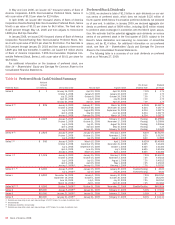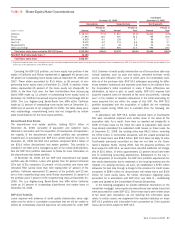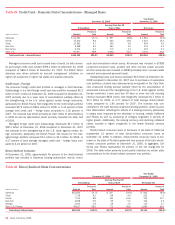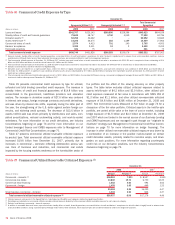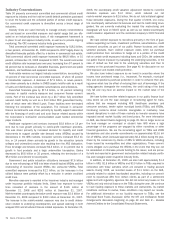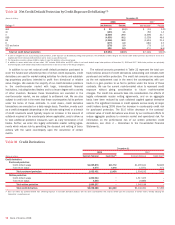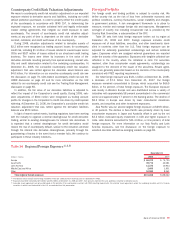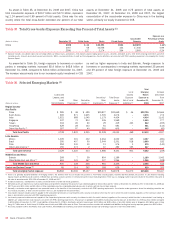Bank of America 2008 Annual Report Download - page 72
Download and view the complete annual report
Please find page 72 of the 2008 Bank of America annual report below. You can navigate through the pages in the report by either clicking on the pages listed below, or by using the keyword search tool below to find specific information within the annual report.Commercial Portfolio Credit Risk Management
Credit risk management for the commercial portfolio begins with an
assessment of the credit risk profile of the borrower or counterparty
based on an analysis of their financial position. As part of the overall
credit risk assessment of a borrower or counterparty, most of our
commercial credit exposures are assigned a risk rating and are subject to
approval based on defined credit approval standards. Subsequent to loan
origination, risk ratings are monitored on an ongoing basis. If necessary,
risk ratings are adjusted to reflect changes in the financial condition,
cash flow or financial situation of a borrower or counterparty. We use risk
rating aggregations to measure and evaluate concentrations within portfo-
lios. Risk ratings are a factor in determining the level of assigned
economic capital and the allowance for credit losses. In making credit
decisions, we consider risk rating, collateral, country, industry and single
name concentration limits while also balancing the total borrower or coun-
terparty relationship. Our lines of business and risk management person-
nel use a variety of tools to continuously monitor the ability of a borrower
or counterparty to perform under its obligations.
For information on our accounting policies regarding delinquencies,
nonperforming status and charge-offs for the commercial portfolio, see
Note 1 – Summary of Significant Accounting Principles to the Con-
solidated Financial Statements.
Management of Commercial Credit Risk
Concentrations
Commercial credit risk is evaluated and managed with a goal that concen-
trations of credit exposure do not result in undesirable levels of risk. We
review, measure, and manage concentrations of credit exposure by
industry, product, geography and customer relationship. Distribution of
loans and leases by loan size is an additional measure of portfolio risk
diversification. We also review, measure, and manage commercial real
estate loans by geographic location and property type. In addition, within
our international portfolio, we evaluate borrowings by region and by coun-
try. Tables 28, 30, 34, 35 and 36 summarize our concentrations. Addi-
tionally, we utilize syndication of exposure to third parties, loan sales,
hedging and other risk mitigation techniques to manage the size and risk
profile of the loan portfolio.
From the perspective of portfolio risk management, customer concen-
tration management is most relevant in GCIB. Within that segment’s
Business Lending and CMAS businesses, we facilitate bridge financing
(high grade debt, high yield debt, CMBS and equity) to fund acquisitions,
recapitalizations and other short-term needs as well as provide syndi-
cated financing for our clients. These concentrations are managed in part
through our established “originate to distribute” strategy. These client
transactions are sometimes large and leveraged. They can also have a
higher degree of risk as we are providing offers or commitments for vari-
ous components of the clients’ capital structures, including lower rated
unsecured and subordinated debt tranches and/or equity. In normal
markets, many of these offers to finance will not be accepted, and if
accepted, these conditional commitments are often retired prior to or
shortly following funding via the placement of securities, syndication or
the client’s decision to terminate. However, as we began to experience in
the latter half of 2007, where we have a binding commitment and there is
a market disruption or other unexpected event, these commitments are
more likely to be funded and are more difficult to distribute. As a con-
sequence there is heightened exposure in the portfolios and a higher
potential for writedown or loss. For more information regarding the Corpo-
ration’s leveraged finance and CMBS exposures, see the CMAS dis-
cussion beginning on page 40.
We account for certain large corporate loans and loan commitments
(including issued but unfunded letters of credit which are considered uti-
lized for credit risk management purposes), which exceed our single
name credit risk concentration guidelines at fair value in accordance with
SFAS 159. Any fair value adjustment upon origination and subsequent
changes in the fair value of these loans and unfunded commitments are
recorded in other income. By including the credit risk of the borrower in
the fair value adjustments, any credit deterioration or improvement is
recorded immediately as part of the fair value adjustment. As a result, the
allowance for loan and lease losses and the reserve for unfunded lending
commitments are not used to capture credit losses inherent in these
nonperforming or impaired loans and unfunded commitments. The
Commercial Credit Portfolio tables exclude loans and unfunded commit-
ments that are carried at fair value to adjust related ratios. See the
Commercial Loans Measured at Fair Value section on page 74 for more
information on the performance of these loans and loan commitments
and see Note 19 – Fair Value Disclosures to the Consolidated Financial
Statements for additional information on our SFAS 159 elections.
The merger with Merrill Lynch will increase our concentrations to cer-
tain industries, countries and customers. These increases are primarily
with diversified financial institutions active in the capital markets. There
are also increased concentrations within the high-grade commercial
portfolio, monoline insurers, certain leveraged finance exposures, and
several large CMBS positions.
70
Bank of America 2008


